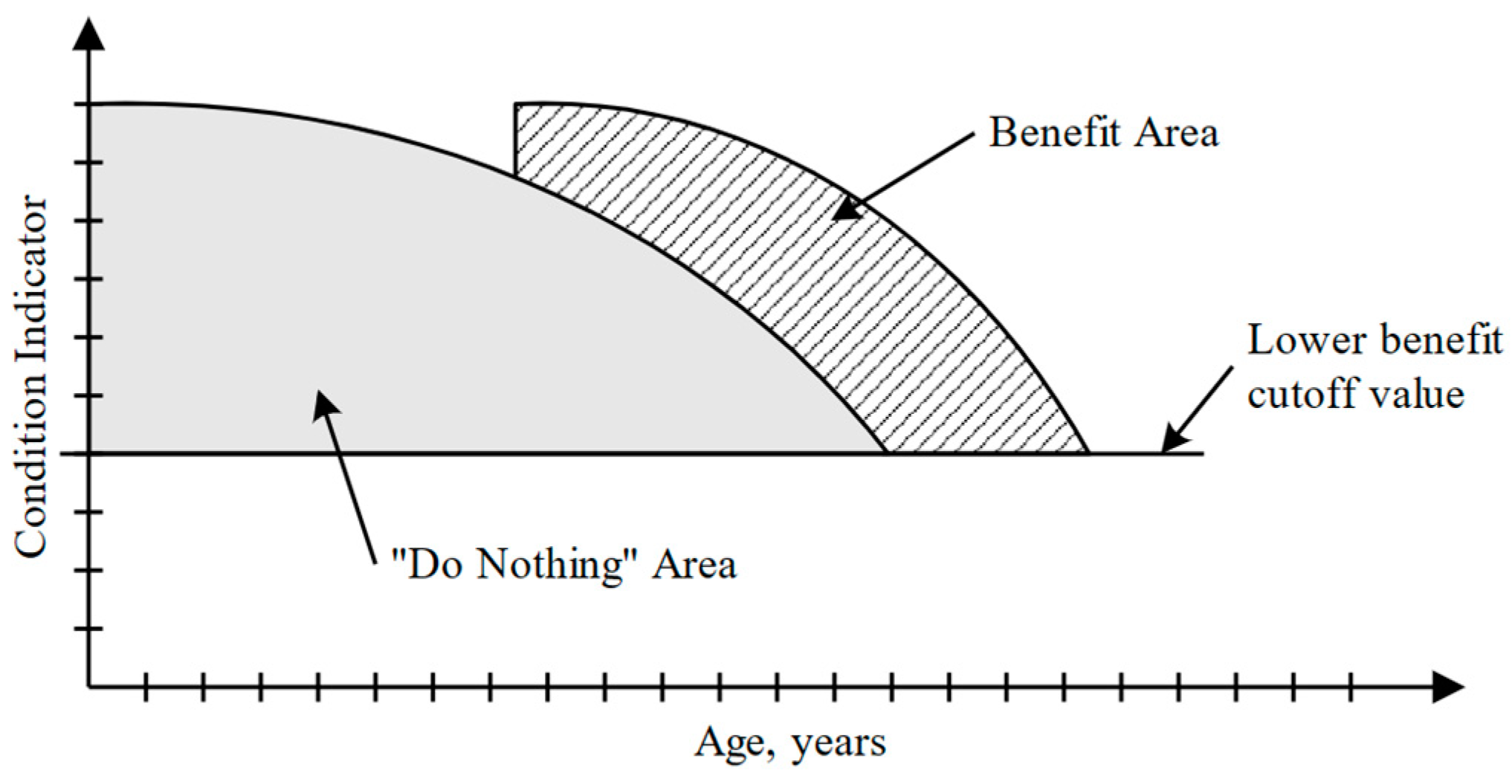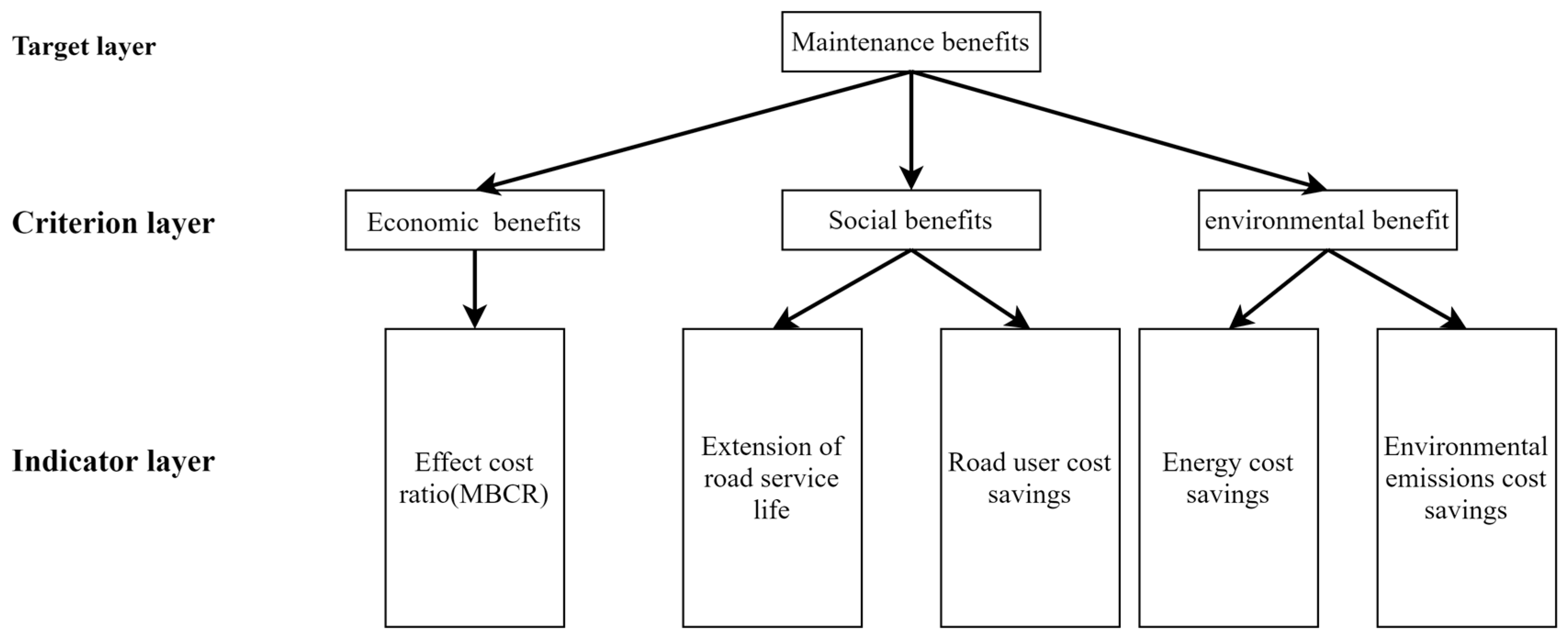2.2.1. Normal Operating User Costs
This refers to user costs during normal highway operations (non-work zone). It has a direct relationship with pavement performance. For each candidate preventive maintenance schedule, this cost can be estimated using the following models: Each preventive maintenance schedule has its own associated expected performance model (level of condition at each year of the schedule). Then, using cost-condition models, the user cost associated with each preventive maintenance schedule can be determined.
(1) Vehicle Operating Costs
Vehicle operating costs mainly include fuel consumption during driving, tire wear, and maintenance material consumption.
① Fuel consumption cost
Fuel consumption is the cost generated by the consumption of power energy during the driving process of the vehicle. The vehicle fuel consumption cost of the road section is calculated by Formula (3) [
22]:
where
—vehicle fuel consumption cost of the road section (yuan)
—traffic volume of the road section (vehicle/y)
—unit price of fuel oil (yuan/L); the current reference price of gasoline is 7.16 yuan/L; and the price of diesel oil is 6.76 yuan/L
—the section distance (km),
—unit vehicle fuel consumption (L/100 km); the calculation formulas of fuel consumption, vehicle speed, and IRI of different models are shown in
Table 2:
Table 2.
The relationship between fuel consumption, speed, and IRI [
23].
Table 2.
The relationship between fuel consumption, speed, and IRI [
23].
| Vehicle Type | Relationship Model |
|---|
| passenger car | |
| bus | |
| small truck | |
| big truck | |
② Tire Wear-and-Tear Cost
Tire wear and tear cost refers to the depreciation cost of tires caused by the continuous wear and tear of surface materials caused by mechanical and chemical reactions during the relative movement of tires and road surfaces during the vehicle’s operation [
24]. The tire consumption cost of vehicles on the road section is calculated using the following formula [
22]:
where
—vehicle tire consumption cost of the road section (yuan)
—Tire unit price (yuan/piece), as shown in
Table 3.
—Tire loss per unit vehicle (per 1000 km) The calculation formula for tire consumption and IRI of different vehicle models is shown in (5) [
19]:
where
,
is the regression coefficient [
21], and the regression coefficients for different vehicle models are shown in
Table 4.
③ Repair and Maintenance Cost
The vehicle repair and maintenance costs mainly involve labor costs and material consumption costs during the repair process. The vehicle repair and maintenance cost for the road section is calculated using the following formula [
22]:
where
—vehicle Repair and Maintenance cost of the road section (yuan)
—Unit price of a new vehicle (yuan/vehicle),
—The ratio of maintenance cost per kilometer for 1000 vehicles to the price of a new car. The calculation of R for different vehicle models is shown in Equations (7) and (8) [
21].
where
, —The regression coefficient of the model;
—Maintenance cost coefficient;
—Vehicle aging coefficient;
—Total vehicle mileage;
Among them, the recommended values of the e, f, K, and p coefficients are shown in
Table 5.
(2) User Travel Time cost
The cost of vehicle travel time generally refers to the value generated by the opportunity cost of the time consumed by the vehicle during travel [
25]. The vehicle travel time cost of the road section is calculated using the following formula:
where θ—the time value coefficient (yuan/h), usually related to the personal income of regional travelers [
26].
—the travel time of a single vehicle before maintenance (h). The functional relationship between
and the
can be obtained through tests on a large number of road sections, which is expressed as follows [
27]:
(3) Accident cost
The vehicle accident cost refers to the cost caused by the loss caused by the traffic accident of the vehicle driving on the expressway. For the loss cost of a single traffic accident, my country makes a preliminary division according to the different degrees of the accident. The specific accident cost is shown in
Table 6.
This article uses the relationship between the number of occurrences of various vehicle models at different accident levels obtained by Mao Xinhua through regression [
6], as shown in
Table 7.
Table 7.
Relationship between Annual Accidents of Different Vehicle Types.
Table 7.
Relationship between Annual Accidents of Different Vehicle Types.
| Vehicle Type | Property Damage Only | Injury Accident | Fatal Accident |
|---|
| passenger car | | | |
| bus | | | |
| small truck | | | |
| big truck | | | |
According to the number of annual traffic accidents, combined with the accident cost
, the annual traffic accident cost can be calculated [
8].
where
—Annual traffic accident vehicle accident costs (yuan)
—the number of accidents per year; the calculation formula is shown in
Table 7.
—The loss cost of a single traffic accident (yuan); the value is shown in
Table 6.
2.2.2. Work Zone-Related User Costs
Since maintenance activities need to close some lanes, the lanes are compressed, the vehicle speed is reduced, or even congestion occurs, and the resulting increase in user costs can be calculated through the additional fuel and time costs due to vehicle delays.
Based on the FHWA report [
29] entitled “Work Zone Road User Costs: Concepts and Applications,’’ in this study, we provided an improved calculation method to estimate the fuel consumption associated with speed changes through the work zone areas. Limited by the length requirement, for the present study, we list only the improved inputs here.
The formula for calculating fuel consumption related to the work zone is as follows:
—The average instantaneous acceleration/deceleration fuel consumption emission rate of the i type of vehicle (g/s/vehicle)
—the speed change time per vehicle of vehicle type i in seconds
—the number of affected vehicles of type i under speed change conditions
—the change in the fuel consumption rate of the -th type of vehicle at its original speed and restricted speed (L/km/vehicle)
—the number of affected vehicles of type i under speed reduction conditions.
—work zone length (km)
—the change in the fuel consumption rate of the i-th type of vehicle at its original speed and detour speed (L/km/vehicle)
—the number of affected vehicles of type i-th under detour conditions.
—Detour distance (km).
—The change in the fuel consumption rate of the i-th type of vehicle at its original speed and queue speed (L/km/vehicle)
—the number of affected vehicles of type i under queue conditions.
—queue length, km.
Unlike the methods used in the FHWA report to determine various fuel consumption costs related to speed changes, this study used a micro-vehicle-based model.
This model provides a better method to estimate vehicle fuel consumption under changing vehicle speed conditions, which can consider the fuel consumption caused by acceleration and deceleration modes at various speeds [
30]. This specific model was developed by combining on-site experiments with the comprehensive mode emission model (CMEM). On-site experiments collected second-by-second vehicle speed and acceleration data on highway sections during peak hours and working hours, and then CMEM generated second-by-second emissions of light-duty vehicles and high-duty vehicles. For more information on this method, please refer to the publication in [
30].
Therefore, the additional fuel consumption cost of vehicles in the work zone area is calculated as shown in Equation (15).
According to the FHWA report, Life-Cycle Cost Analysis in Pavement Design [
31], the following Formulas (16) and (17) can be used to calculate the delay time of work zones and queues. For more information on this method, view the publication of [
31].
Therefore, the additional time cost for the work zone is calculated as shown in Equation (18).








